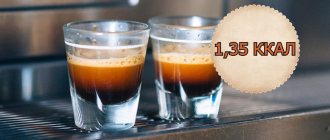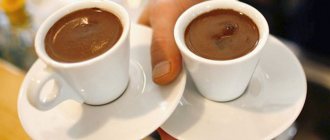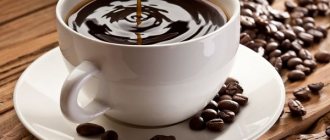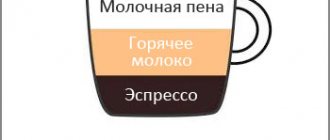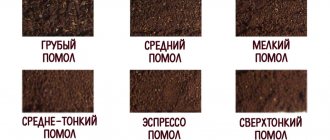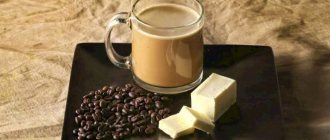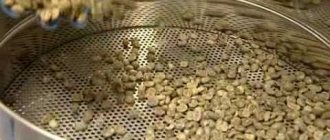There is a word express and the word espresso. In modern usage they have nothing to do with each other, as literate speakers of the Russian language continue to insist on.
Article on the topicCoffee - he or it. Which is correct?
There is a third word - expresso - an error resulting from contamination, a spontaneous crossing of the words express and espresso . We know that the main complaint of literate people about the word expresso is that those who make mistakes in this word are guided by a false etymology: according to them, the word expresso means “quickly prepared coffee.”
Indeed, when there are two similar words, the meaning of one of which is known or intuitively understood, this clear meaning is attributed to the second word. Express in our understanding is something fast. This means that e(k)spresso is some kind of “fast” product.
(By the way, in the Russian language there are, in general, a lot of false etymologizations: juicy from the word juice , dovely from the word crush , etc.)
Thus, competent native speakers assume that the words express and espresso are simply similar, nothing more. They have nothing in common, and calling coffee expresso is simply indecent. Some teach others, explaining that express is something urgent or special, and espresso is something that is prepared under pressure, under pressure , because espresso means squeezed out . The latter, upset by their stupidity, try to remember the difference, and those who know triumph, it must be said, somewhat prematurely.
The word express (both in the meaning of a vehicle and in the meaning of something special, urgent) comes from Lat. expressus - expressive, sharply standing out, intelligible; expressus is the past perfect participle of exprimo. And exprimo (ex-primo) - yes, yes, squeeze out, squeeze out.
Article on the topic: Probably or probably - which is correct?
The word espresso comes from esprimere, which translates as to express. It turns out that everything is turned upside down: etymologically, the vehicle is “squeezed”, and coffee is “expressed”? Yes, the word espresso also has a meaning to squeeze, but it’s far from the first one. But “to make something espresso” in Italian means “to do it specially and quickly.” In Italy, there were establishments where you could ask them to make spaghetti from prepared dough immediately, right now, and such a dish was called “espresso spaghetti.”
- The origin of the word Latte, how to pronounce and emphasize it correctly
Linguists also claim that the word espresso , meaning train, came into Italian from the French exprès , which completely changes our ideas about the truth. (In Italy there are train classes: P - regional, E - espresso, etc.)
Now it is obvious that the words espresso and express are not alien at all - you can endlessly drown in etymological dictionaries and talk with native speakers, finding out how espresso and express are. But the main thing is that this example gives us a good lesson: before insisting on any fact and teaching others, we should think about whether everything is so simple and unambiguous.
Returning to the modern Russian language, we remind you that today the words express and expresso , despite their interesting history, are still clearly separated lexically and orthographically.
Express is a vehicle or something urgent or special.
Espresso - coffee. Without K !
What is espresso
It contains only 2 ingredients: water and ground coffee beans. You can see the drink in the photo. Read the description before use.
Creamy foam
The golden foam that forms on the surface is called “creama”. The Italians claim that it is the juice of coffee beans. Water entering under pressure dissolves carbon dioxide, resulting in the formation of a dense cap. The foam should be uniform. Whitish spots indicate excess caffeine.
Liquid part
The liquid part is conventionally divided into 2 halves. Immediately below the foam is a caramel-brown “body”. The “heart” is at the bottom of the glass. This part is a darker brown shade.
The many faces of espresso italiano
The appearance of rapid espresso Italiano pleased bartenders the most. Based on the strong drink, they could now prepare dozens of different coffee cocktails. The range of establishments has expanded significantly. Let's count how many types of coffee are prepared on the basis of espresso and what are the features of each.
| № | Drink name | Peculiarities |
| 1 | Ristretto | The strongest coffee drink. Similar to espresso, but its preparation requires half the volume of water with the same amount of coffee. |
| 2 | Doppio | Double shot of traditional espresso. |
| 3 | Trippio | Triple shot of espresso. |
| 4 | Americano (lungo, regular) | America's favorite drink. The amount of water for its production is increased, and the dose of coffee is reduced. Simply put, it's espresso with double the amount of water. The caffeine content in the drink is reduced, which is good for those for whom strong coffee is contraindicated. |
| 5 | Cappuccino | A mixture consisting of three parts: espresso, milk and milk foam. One of the most popular coffee cocktails in the world. |
| 6 | Latte | A mixture of espresso and milk, on top of which there is a layer of airy milk foam. |
| 7 | Macchiato | A shot of espresso is poured into the foamed hot milk from above in a thin stream. A brown spot of macchia appears on the white foam, hence the name of the cocktail. |
| 8 | Mocha | A cocktail of espresso, hot chocolate, milk and milk foam. |
| 9 | Glyase | Cold drink made from espresso and ice cream. |
| 10 | Romano | A little lemon juice is added to the espresso, and the drink is decorated with a slice of lemon. |
| 11 | Con panna | The espresso is topped with whipped cream and sprinkled with chocolate shavings. |
| 12 | Frappe | Chilled espresso shaken with sugar and crushed ice. |
This is the main dozen options! The list goes on.
In the barista's vocabulary there is the concept of shot espresso. This is a professional accessory in the form of a cup with measuring divisions. With its help, the required amount of coffee is determined when making cocktails or serving a serving of the correct size. It is most often used in professional training; experienced bartenders easily calculate the volume visually.
Important: “shot” should not be confused with the term “meal”! Although these are consonant words, they are from different areas. Meal is the coffee grounds that remain at the bottom of the cup after drinking coffee. This is what fortune tellers use to determine your past, present and future.
History of the name and origin of espresso
Translated from Italian, espresso means “prepared freshly, here, especially for you.” Proof of this version was the existence of freshly cut espresso spaghetti, sold in spaghetti in the 50s. XX century
The second hypothesis about the origin of the name indicates the similarity of sound with the terms “compressed”, “under pressure”. This theory arose because the liquid during the preparation of the drink is supplied under pressure.
The third version notes the similarity of the name with the word expresso. Aromatic, strong coffee can be prepared in just 30 seconds.
The novelty appeared at the beginning of the twentieth century. in Italy. Then the first coffee machines were invented, with the help of which the time for brewing coffee was greatly reduced.
The disadvantage of the first experiments was the deterioration in the taste of the drink in comparison with the version prepared in cezves. The problem was solved by Achille Gaggia, a bartender from Milan.
He came up with a new cooking technology in which hot water was supplied under high pressure. Since the liquid temperature did not reach 100°, the flavor of the beans developed. At the same time, there was no burning sensation.
The drink spread throughout the world in the 60s. XX century After the war, many local residents moved from Italy to neighboring countries. When moving, the Italians opened a cafe where espresso was always on the menu.
The drink came to the United States of America, Russia, and European countries, where it quickly gained popularity. It was appreciated even in Asia. Residents of eastern countries, however, prefer chilled, diluted with ice, to the classic version.
Why is there confusion with the words "express" and "espresso"?
Philologists explain the resulting confusion with the words “express” and “espresso” by the fact that people are influenced by an erroneous “etymology”, according to which the name coffee means a quickly prepared aromatic drink. According to experts at the Institute of Philology, this occurs as a result of the substitution of concepts, when a closer meaning of a word is assigned to another, similar in sound and spelling.
But the word forms “espresso” and “expresso” are not close in meaning or related. These are completely different units with their own lexical meaning and pronunciation. And calling coffee “expresso” in this case is indecent.
Classic cooking technology
The Italians claim that the quality of espresso depends on 4m:
- miscela (grain mixtures);
- macinadosatore (degree of grinding);
- maccina (coffee machines);
- mano (barista abilities).
Suitable coffee type
A mixture of 3-5 varieties of Arabica is used. Robusta is allowed to be mixed in small quantities to obtain a stronger drink with thick foam. There should be no aromatic additives.
It is not recommended to use ground coffee. It will lose its aroma after 2-3 weeks of storage. It is better to grind the grains immediately before cooking.
Choose a medium to dark roast. When choosing Italian or French, the sourness will disappear from the taste. At the same time, the bitterness will increase.
Grinding degree
The grind should be finer than medium, but coarser than fine. If you choose too large, the coffee will turn out to be liquid and will lose its taste. Excessively ground beans can clog the coffee maker filter.
Suitable coffee maker model
The right espresso coffee maker has a number of characteristics:
- The holder must be made of stainless steel. When heated, the plastic part will begin to spoil the aroma of the coffee. The drink will smell like chemical additives.
- The pressure in the chamber should be 9 bar. The pump should provide a reading of 15 bar.
- The temperature of the liquid in the boiler should increase to +87°...+95°. If the heat is too high, a burnt taste will appear, and if the heat is too low, the coffee will turn out liquid and not tart enough.
Preparatory stage
Do not pour too many beans into the holder, otherwise it will be difficult to tamp with the distemper. Make sure the coffee is pressed evenly. Water may pass through areas of lower density, causing the espresso to be thin.
Choose the right tamper. Avoid aluminum and plastic products. They are too fragile and will quickly become unusable.
Give preference to stainless steel tampers. For single holders, choose a product with a flat base. For doubles, rounded temperas are better suited.
Brewing Features
To compress beans for a carob coffee maker, you will need a force of 19-20 kg. Give preference to filtered water. Distilled liquid reduces the strength, too hard spoils the aroma.
Fill a slightly warmed ceramic cup with the finished drink. Do not pour from one container to another.
Is Turk suitable?
You won't be able to make espresso at home using a cezve. Ground grains in a Turk remain in a gradually heating liquid for a long time. Because of this, caffeine and essential substances are released differently. At home, it is possible to prepare Turkish black coffee in a cezve.
Wait, isn't espresso coffee?
Yes. Coffee is a liquid that is obtained from beans, not a brewing process. A good cup of espresso can be obtained by specially preparing Robusta or Arabica coffee beans.
Think about how many different methods of making coffee there are: French press, pour over, percolator, etc. So, any espresso is coffee, but not all coffee is espresso.
Espresso is not a specific type of coffee bean. However, when roasting beans that are destined to become espresso, they may undergo special processing. Roasters typically use high quality Robusta beans to produce a richer coffee.
Characteristics of espresso
The drink has a number of features.
Standard volume
For a classic espresso shot, the volume varies from 25 to 30 ml with foam. In Russia and Scandinavia they prefer to add more water, up to 60-80 mg.
Caffeine content and daily intake
One classic serving contains 50-68 mg of caffeine. It is recommended to drink no more than 1-3 shots per day. In some situations, it is allowed to increase the dosage to 7 cups. This amount of strong coffee cannot be drunk regularly.
Calorie content of the drink
Calorie content per 100 g is 9 kcal. The energy value of a serving depends on how many grams of coffee it contains. On average, the figure varies from 2.5 to 3 kcal.
Beneficial features
When consumed in moderation, the drink will benefit the body:
- The risk of developing cancer is reduced.
- If you drink a cup after a meal, the food will be digested faster.
- Coffee will help you cheer up. Drinking the drink before training can improve your performance.
- If a man prefers to drink espresso in the morning, his potency and libido will increase. You should not drink coffee in the evening, as the effect will be the opposite.
- Drinking the drink between meals will help reduce appetite and prevent overeating.
- Regular consumption improves mood and stimulates brain function.
Harm to health
Pregnant and lactating women should avoid strong coffee. Caffeine can cause uterine contractions and cause miscarriage or premature birth. The substance penetrates into breast milk and overloads the baby’s nervous system.
Drinking a cup of espresso on an empty stomach will lead to heartburn, discomfort, and abdominal pain in people with disorders of the digestive system.
It is dangerous to drink coffee if you have pathologies of the heart or blood vessels. The drink increases blood pressure and increases heart rate.
Which rule applies
There is no rule as such, because “espresso” is a borrowed word that came to us from the Italians. To understand the logical chain of changes in this word, let us turn to the history of its appearance.
Initially, it arose from the Latin word “exprimo”, that is, “to squeeze out”. It turns out that the historical version of the word still contained the letter -k-. But this concept did not come into the Russian language directly from Latin. The Italians were the first to brew strong coffee, which means they had to come up with the name for the new drink.
Here the opinions of linguists differ; there are two opinions:
- Italians borrowed the word from Latin, but, as in other similar cases, replaced -x- with -s- to make it easier to pronounce;
- the second version is that the word was formed from the verb “esprimere”, which means “to express”.
Both options may be correct and logical. Because coffee has really pronounced bitter notes that cannot be confused with anything else.
The word "espresso" is often misspelled and pronounced because people compare it to the similar word "express." It means speed and speed (express train or express course). And the drink itself is prepared quickly, which is why it creates erroneous associations in a person’s head.
Example sentences
Here are some example sentences to help you remember how to spell “espresso”:
- Only this coffee shop knows how to make espresso best.
- Remember that I like double espresso without sugar.
- Without any problems, they can serve you excellent espresso in an inconspicuous eatery, and in a restaurant they can bring you a drink.
- On the table in front of her was a cup of steaming espresso and a plate of fluffy cake.
You can use this word in all styles of speech, if necessary. In the text it can act as any member of a sentence - it depends on the context in which the word is used.
How to write incorrectly
Incorrect spelling with the letter -k-. This mistake is so common that it's really easy to remember. Even today this word can be seen on signs in all coffee shops and cafes. You just have to look closely and remember the spelling. In addition, do not forget about the double -s- in the word; other spellings are perceived as an error.
Espresso-based coffee drinks
Dopio or double espresso is a standard serving doubled.
Coretto is made by adding a few drops of grappa or Scotch whiskey to a cup.
To obtain Romano, pour in 5 ml of lemon juice and sprinkle with zest.
To prepare Americano, add boiling water. In cafes, hot water is often served separately so that the visitor can independently adjust the strength.
If you add milk or cream, you get raffe, cappuccino, latte.
Article on the topic: Rules for preparing and drinking coffee macchiato
Good coffee is an expensive pleasure!
In general, I am an absolutely indiscriminate coffee drinker. From the category of those who don’t really know the difference between Americano and filter coffee. I usually drink a completely banal cappuccino with sugar. But recently a very interesting story happened to me, after which I began to be much more attentive to buying coffee. Rostov-on-Don. Hotel. Reception - Girl, please, take a cappuccino with sugar with you. - Yes, sure. Would you like some raf? - Raf? - Yes, I can do it with syrup! Nut, orange and vanilla to choose from. - Well. let's have an orange one. Five minutes pass. - Your rough is ready. Attach your card. Out of habit, I take out my phone, put it on the terminal, hear a familiar sound about payment and... FUCKING FUCK! Raf cost me 800 rubles! EIGHT HUNDRED, Karl! I remain calm and pull myself together. – Why is it so expensive, girl? - Well, it’s raf! At its best, like in the capital, with syrup. - But eight hundred rubles for coffee? - Yes, if you don’t like something. - Whoa, don't get excited! This is simply the most expensive coffee of my life! And I have a feeling that I will not get pleasure from it for the entire amount paid! And then she gives it away. whisper, quietly. – To have fun, you didn’t have to buy coffee, but throw in two hundred rubles and contact the security guard! He has a phone number. So I realized that prostitutes in this hotel cost two hundred rubles more than a glass of coffee.
Homemade recipe
To prepare a classic espresso recipe at home, you will need 7 g of coffee beans and 40 ml of water. If desired, you can add granulated sugar. Connoisseurs claim that it spoils the taste and recommend refraining from using sweeteners.
If you are using a coffee machine with a built-in coffee grinder, add 1 tbsp. whole grains. For carob coffee makers, you will have to use pre-ground raw materials.
To measure quantities, use a measuring cup. Press the beans in the holder using a tamper, then place the part in the coffee maker. Place the cup in the drip tray and wait 25-30 seconds. Sweeten the finished drink if desired.
When you want to make another drink based on strong black coffee, use the same method as when making espresso.
Right
Espresso - since the noun is borrowed from Italian, where it is written as “espresso” (without the letter “k”), in Russian the letter “k” is also not written. The correct spelling is recorded in modern dictionaries. To remember the correct spelling, you should know that in Italian one of the meanings of the word espresso is “squeezed out,” so in this context the word has nothing to do with speed (express). I will have one cup of espresso and one jelly. The espresso was made from natural coffee. Every morning I drink a cup of espresso. Espresso is served in small coffee cups.
